
Business intelligence in healthcare: Benefits and the best tools
Speed and accuracy of decisions in the healthcare industry are critical at all levels: operational, clinical, and financial. Ensuring enough beds for all patients, keeping track of surgery outcomes, and maintaining ethical relationships with insurance companies. Administrators, clinicians, and executives in the healthcare sector face these and many more decisions every day.
They don’t have time for:
- lagging software
- inaccurate or outdated patient data
- lack of consistency across healthcare systems
Instead, they need:
- relevant up-to-date insights available at their fingertips
- consistent data across different systems
- high-performance data analytics tools that don’t disrupt but enhance their workflow
Customized busines intelligence (BI) solutions can fulfill those needs and help you ensure business visibility by tracking relevant key performance indicators (KPIs) in real time, such as hospital profit by region or city, number of claims submitted to insurers, patient visits by practice, or total visits by hospital.
In this blog post, you’ll find out how your medical practice can benefit from business intelligence, the role of business intelligence in the healthcare industry, and which BI data platform you can integrate to satisfy your needs.
Need a custom healthcare business intelligence implementation strategy?
Contact usTop 3 benefits of business intelligence in healthcare
The biggest value of business intelligence for healthcare is the ability to visualize data on interactive dashboards that can come in different forms, such as pie charts, bar charts, line charts, histograms, tables, and maps. Data visualization is primarily the process of transforming raw clinical or patient data into insights showing how a particular metric (e.g., company revenue) has changed over a certain period.
Healthcare business intelligence tools can be beneficial in multiple ways. Below, we discuss some of them in detail.
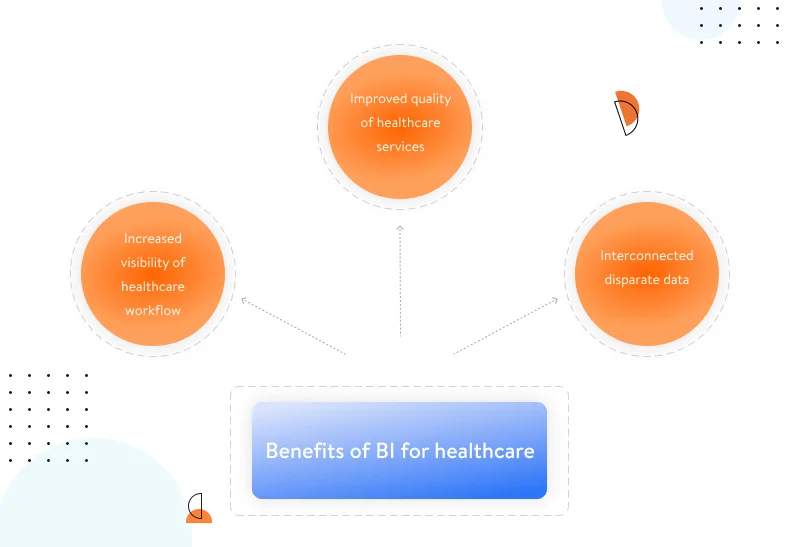
Increase the visibility of the healthcare workflow
With the possibility to collect and analyze large amounts of cross-functional healthcare data, clinical business intelligence software can allow you to make data-driven decisions based on the latest status of your key operations. For instance, you may have underestimated your most revenue-generating services and have not invested enough in their marketing. Advanced analytics can also allow you to forecast how your business performance can change with time by drawing on historical data. Thus, you can form the big picture of your healthcare organization’s operations from current and future perspectives.
BI in healthcare practices can also help define the most crucial and not-so-obvious bottlenecks. This gives you a chance to optimize your daily operations and answer the following questions:
- How can we improve efficiency and decrease patient treatment times?
- How much revenue do we generate, and how can we generate more?
- What’s the average cost of providing care to patients, and how can we reduce costs without compromising quality?
You can easily answer these and many more questions with the help of healthcare data analytics.
Improve the quality of healthcare services
Healthcare business intelligence services also allow you to analyze global healthcare trends or apply global healthcare statistics on patient care or medication use to keep your clinical practices up to date.
You can also consider analyzing patient feedback to meet patients’ or customers’ needs and be proactive when it matters most. For instance, you can track patient wait times at your hospitals and immediately investigate if this metric exceeds a certain threshold.
Healthcare business intelligence tools can also help you provide more personalized and coordinated patient care, as you’ll be able to track your patients’ treatment progress, treatment time, satisfaction rate, and many other practice-specific metrics. With these valuable insights, you can see how each of your patient groups is feeling and what you can do to improve their experience.
Learn how to enhance your services and the patient experience with remote patient monitoring.
Read the postConnect disparate data across departments and facilities
Modern healthcare BI tools can collect lots of data siloed in different healthcare departments into a single platform to give you a helicopter view of your business. A single healthcare practice can have more than 100 digital healthcare systems, each generating unique data used mostly for meeting the needs of a certain department. Let alone third-party integrations, such as, for instance, with pharmaceutical companies to enable e-prescriptions.
Imagine what could happen if you break data silos by implementing business intelligence in health systems and use consolidated datasets to generate valuable healthcare insights. For starters, you could immediately get deeper insights into your overall business workflow and determine practical data-driven actions to increase your business productivity and efficiency.
To achieve all of these results, you need to integrate a robust data analytics solution that meets your industry standards. Let’s move on to the practical application of healthcare BI tools.
Real-world applications of business intelligence in healthcare
Use of business intelligence in healthcare isn’t an isolated, standalone process, it’s usually interconnected with the internal and external systems and data sources that are relevant for your medical practice. It could be your EHRs, patient satisfaction surveys, or medical imaging software. Your current issues and priorities define which reports and dashboards to build. Let’s review four case studies of healthcare leaders who adopted BI and data analytics and learn what they achieved with improved healthcare data analysis.
1. Maidstone and Tunbridge Wells NHS Trust (UK): From manual paper records to cost-efficient insights
Before the COVID pandemic, nurses at two hospitals of this NHS Trust still used paper and pencils to track patients and manually allocate beds for them. Such a process was highly inefficient and time-consuming. To fix this, hospitals adopted BI solutions and started analyzing patient flow in real time, and set up bed management analysis. The implementation led to:
- A reduction of emergency department wait times by one hour per patient
- A decrease in bed turnaround time by 1.5 hours, freeing up an average of 15 beds daily
- Annual savings of approximately £2.1 million
2. Santeon Hospitals (Netherlands): Data-driven value-based care
Santeon, a network of seven leading teaching hospitals in the Netherlands, has successfully implemented a collaborative healthcare analytics and business intelligence platform to drive value-based healthcare improvements. The hospitals harmonized their once-disparate data systems into a unified Health Intelligence Platform (built on a Microsoft cloud BI stack) that allows them to share and compare clinical outcomes transparently across the network.
Through this collective business intelligence approach, Santeon’s clinicians analyze performance metrics and learn best practices from each other in real time, identifying which treatments lead to better patient outcomes.
The impact has been impressive, Santeon hospitals:
- reduced unnecessary inpatient stays by nearly 30%
- cut re-operation rates due to complications by 74% for breast cancer patients within 18 months
This outcome-focused use of data is transforming care processes across the group.
“We are convinced that connected data can provide the key to addressing these challenges… By connecting data, our physicians can learn from each other to improve healthcare,” said Renske Veenstra, Santeon’s program lead for the platform, emphasizing how shared analytics enable better patient outcomes at scale.
3. EvergreenHealth (Kirkland, WA, USA): COVID-19 insights that set the tone for the U.S. healthcare system
EvergreenHealth, located in Kirkland, Washington, was at the forefront of the COVID-19 pandemic in the United States. In response to the rapidly evolving situation, the health system used BI tools to manage the crisis effectively and improve healthcare delivery and population health.
Key initiatives and outcomes:
- Improved reporting on test results. Data visualization tools and dashboards helped the clinic quickly analyze test results and view real-time information on such key metrics as: number of tests completed, number of positive test results, and location in the hospital of COVID-19 inpatients.
- Enhanced transparency and internal communication. BI dashboards were shared across departments to unify the response and align clinical teams on health outcomes. Leadership used data from the BI platform to communicate current status and expectations.
- Customization capabilities. With time, the clinic could also add extra data for the analysis, such as ventilator settings, co-morbidities, medications, age groups, and race/ethnicity. In this way, they could grasp a big picture of the disease’s progress and make comprehensive reports.
Through the strategic application of hospital BI tools and data analytics, EvergreenHealth not only managed the immediate challenges of the pandemic but also laid the groundwork for a more resilient and responsive population health management.
4. HCA Healthcare (USA): Sepsis detection system
HCA Healthcare, a large U.S. hospital network, implemented a real-time analytics system called SPOT (Sepsis Prediction and Optimization of Therapy) to detect sepsis in patients earlier on.
SPOT is an algorithm integrated into HCA’s electronic health record that continuously monitors patients’ vital signs, lab results, and clinical notes, “sniffing out” subtle signs of sepsis 24/7 based on patterns learned from millions of past hospitalizations. The system instantly alerts care teams at the bedside if a patient’s data indicates possible sepsis, prompting immediate evaluation and treatment.
Such early warning healthcare BI solutions can have a dramatic impact. Over five years, SPOT helped save an estimated 8,000 lives by catching sepsis in its earliest stages and prompting faster interventions.
“With sepsis, minutes matter … just as we’ve improved safety in our homes with smoke detectors that ‘sniff out’ possible fire, HCA Healthcare’s SPOT technology now helps detect sepsis earlier, accelerating treatment, improving care … and thereby saving lives,” said Dr. Jonathan Perlin, HCA’s Chief Medical Office.
To achieve tangible business results with business intelligence in the healthcare industry, the implementation should be well-planned and well-suited to your unique needs and business priorities.
Key factors when choosing the right healthcare BI tool
The best way to maximize your benefits from BI adoption is to compare different vendors based on your unique requirements. You can also request custom proofs of concept (PoC) from each vendor of interest to make the best choice. Apart from the price, analyze performance, functionality, security controls, and only then make the final decision. Focusing solely on the cost of the solution may lead to compromises in performance or compliance.
Below are the critical evaluation criteria you should consider when narrowing down your BI options. This list is based on findings from BARC reports on BI adoption across multiple industries and regions, adapted specifically for healthcare environments:
- Data security and privacy. Securing PHI (protected health information) is non-negotiable. Choose vendors with demonstrated experience in healthcare and certifications such as HIPAA, GDPR, or regional equivalents. Look for role-based access controls, audit trails, and encryption capabilities to prevent data breaches and healthcare system abuse, and maintain data integrity to ensure compliance.
- Flexibility and functionality. The more tailored the functionality to your operational, clinical, billing, and insurance workflows, the more value you’ll extract. A strong BI platform should offer customizable tools for data integration, storage, reporting, and visualization. Common functions include:
- Advanced data visualizations for spotting clinical trends
- Ad-hoc reporting for dynamic insights
- Data discovery and data mining to surface hidden correlations
- Predictive analytics for personalized and preventive care
- Price-performance ratio. The correlation between functionality and price should be optimal. It’s best to select tools that offer trial periods and give you time to evaluate whether the system’s features are worth the full price. BI tools may include too much unnecessary functionality or lack those features that you need the most.
- Ability to support a large number of users. For large healthcare providers, it’s critical that not only data analytics departments have access to data analytics reports and dashboards but also administrators, executives, and clinicians. And if the system can support a large number of simultaneous users, it’s a huge plus.
- Large data handling capacity. BI platforms must be able to handle large and complex datasets, EHRs, lab results, claims data, and sensor feeds without slowing down or breaking. Evaluate the tool’s ability to:
- Scale with growing data volumes
- Perform near real-time analysis
- Maintain performance under load
- Ease of use for report designers and recipients. A good platform provides opportunities for both technical and non-technical staff to explore and act on data. BI adoption shouldn’t bottleneck your operations. Look for tools that:
- Are intuitive enough for non-technical users
- Provide drag-and-drop dashboard builders
- Minimize the need for prolonged onboarding or developer support
- Fast query performance. Slow queries that don’t produce expected results can impact the efficiency of the decision-making process. Thus, consider solutions that provide high performance and can align with the process speed at your healthcare organization. If a tool lags in performance but excels in other areas, consult your data engineering team to assess whether optimization is possible.
Armed with selection criteria and an understanding of what might be the highest priority for your data analytics process, let’s review the top five BI tools according to Gartner.
Top 5 healthcare business intelligence software solutions
Tableau
Tableau is one of the most popular healthcare BI tools on the market. Users from the healthcare industry who have implemented it claim Tableau is a feature-rich BI solution with a clear interface that allows them to create a wide variety of healthcare dashboards and provide all stakeholders with constant access to business-critical KPIs.
Key characteristics:
- Rich product selection. You can make use of an extensive set of products that complement each other to deliver a full-service data analytics experience.
- Regulatory compliance. In December 2022, Tableau Cloud acquired HIPAA compliance. Here is a list of all security certifications and standards obtained by Tableau Cloud.
- Data preparation tool. The platform provides automated data preparation and extraction services with the help of the Tableau Prep tool.
- Customization capabilities. You can use a variety of Tableau Developer Tools to customize the platform for each organization’s specific needs.
- On-the-go analytics. Explore the benefits of a dynamic business intelligence system with the Tableau Mobile product.
- Data integration. You can collect data from many databases and files (e.g., PDFs, spreadsheets, and on-premises or cloud-based databases).
- Free trial. You can test the solution by signing up for a free trial version.
- Intuitive interface. Even non-technical users find it rather easy to use Tableau thanks to its clear navigation and user-friendly interface.
- Healthcare templates. You’ll find clinical and business data dashboards with detailed filters and the possibility to duplicate charts and graphs to save time on creating dashboard templates.
- Regular software updates. The company ensures quarterly software updates to prevent risks, troubleshoot issues, and enhance platform capabilities. For instance, in Q4 2022, Tableau released a new feature called Image Role, allowing users to drag images into Tableau.
Prominent clients: Lenovo, Salesforce, Lufthansa, Providence St. Joseph Health, Duke University Health Systems
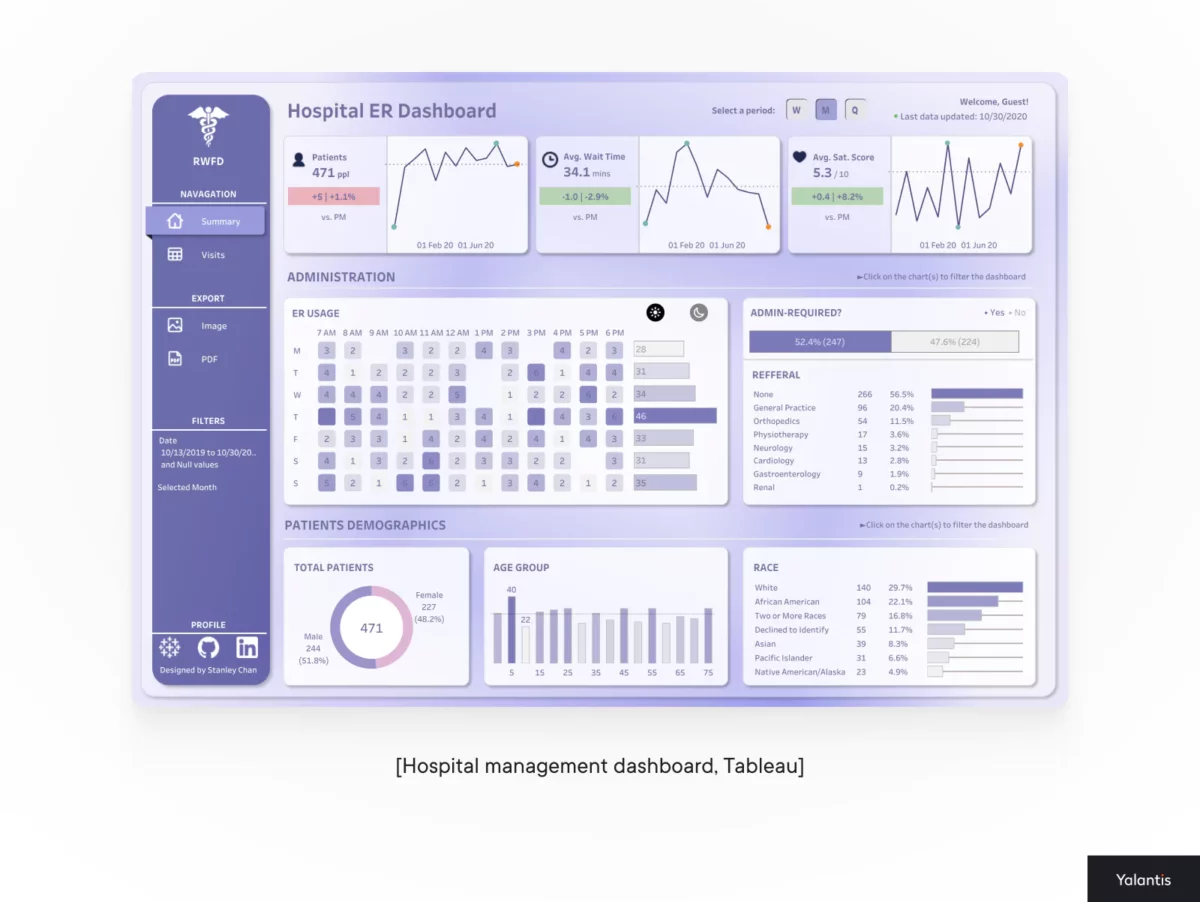
Microsoft Power BI
Power BI has the same level of popularity as Tableau and is also a serious contender in the healthcare industry. This enterprise-level BI platform with advanced analytics capabilities can handle large data sets and has versatile functionality. However, it may require additional training and can, at times, be overwhelming to use. However, there is no doubt that Power BI is an extremely powerful BI platform capable of truly transforming the healthcare industry.
Key characteristics:
- Regulatory compliance. The Power BI platform ensures compliance with a wide range of laws and regulations globally, both healthcare-specific and otherwise, to ensure ultimate data security.
- Data integration. Power BI connects with the majority of databases and supports the majority of file formats on the market, offering more than 500 data connectors. Yet Power BI has limited integration capabilities with third-party tools and services.
- High compatibility with Microsoft tools. You can ensure smooth integration with other Microsoft tools and technologies, such as Microsoft 365 (e.g., Excel) and Microsoft Azure, to generate faster and more data-intensive insights.
- Free desktop tool. The Power BI desktop tool is completely free and easy to install.
- Data preparation. Power Query ETL cleanses and processes raw data and prepares it for further analysis.
- Template visuals. You can choose from a variety of template charts, graphs, and maps to quickly create dashboards that fit your company’s needs.
- Advanced analytics. Power BI is an extremely useful solution for big data analytics and predictive modeling.
Prominent clients: Cerner, INTEGRIS Health, Humana, KPMG, Bayer, PwC
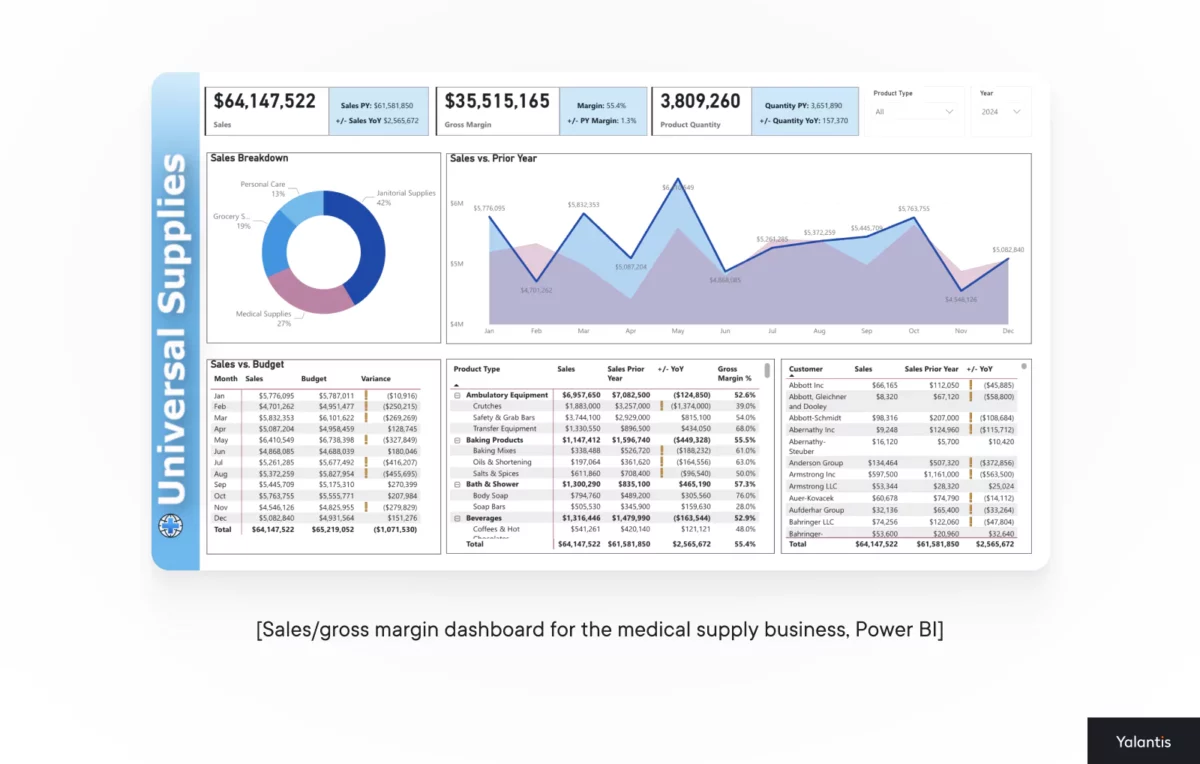
Qlik Sense
The main peculiarity of the Qlik Sense BI tool is that it’s equipped with an associative engine, allowing you to analyze all of your healthcare data and track patterns that would otherwise go unnoticed during the analysis of partial datasets. Here are a few of Qlik Sense’s typical traits that can enhance healthcare decision-making.
Key characteristics:
- Integration with healthcare software. The Qlik Sense platform provides direct integration of embedded analytics into healthcare software such as EHR systems to generate insights while working with patient data.
- Advanced analytics. You can make use of real-time integrations with machine learning algorithms and AI models for even more enhanced healthcare decision-making.
- Edited dashboards. You can visualize healthcare data using dynamic and interactive dashboards that can be easily updated.
- Alerts and notifications. Qlik Sense is also equipped with a data-driven alerting system to keep users updated on recent changes to healthcare data.
- Customization capabilities. A set of open APIs is available to customize the solution to different needs.
- Difficulty of use. Qlik Sense has a steep learning curve and may require consultations from IT staff to fully set up the system.
- High compatibility. The system is compatible with the majority of desktops, tablets, and smartphones.
Prominent clients: NHS, Novartis, Deloitte, DocuSign, PayPal, Ford
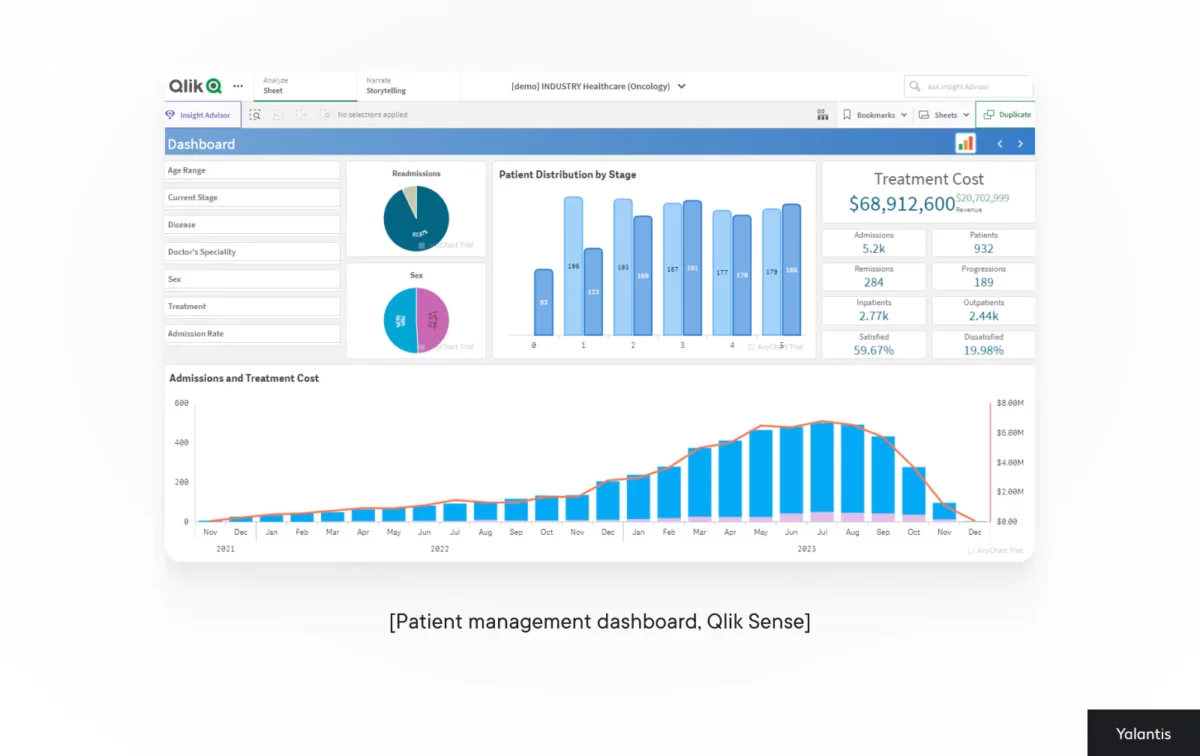
SAP BusinessObjects BI Suite
SAP BusinessObjects is a comprehensive business intelligence platform designed for enterprise-level reporting, analysis, and data visualization. In healthcare, this suite is valued for its robust performance in generating complex reports, enabling large-scale analytics, and integrating seamlessly with SAP’s broader enterprise resource planning (ERP) systems. It supports structured decision-making across clinical operations, financial data management, and regulatory compliance.
Key characteristics:
- Enterprise-grade reporting. SAP BusinessObjects excels at building and managing pixel-perfect reports, enabling healthcare providers to achieve precision in regulatory reporting and financial documentation.
- Security and compliance. The platform offers fine-grained access control and supports healthcare industry standards, including HIPAA, to ensure patient data remains protected against fraud.
- Data integration. Connects smoothly with a wide variety of databases, data warehouses, and SAP HANA systems. This enables a unified view of patient care, financial operations, and resource utilization.
- Ad hoc querying. With SAP BusinessObjects Web Intelligence, healthcare users can perform real-time, ad hoc data analysis without depending on IT teams for every request.
- Collaboration tools. The suite includes functionality for sharing dashboards and reports across departments, enhancing communication between clinical, administrative, and executive teams.
- Legacy compatibility. Many hospitals and healthcare institutions that already use SAP ERP or clinical solutions find the BI Suite highly compatible and cost-effective to adopt.
Prominent clients: Roche, PwC, Stripe, Pfizer, Boehringer Ingelheim, Henkel
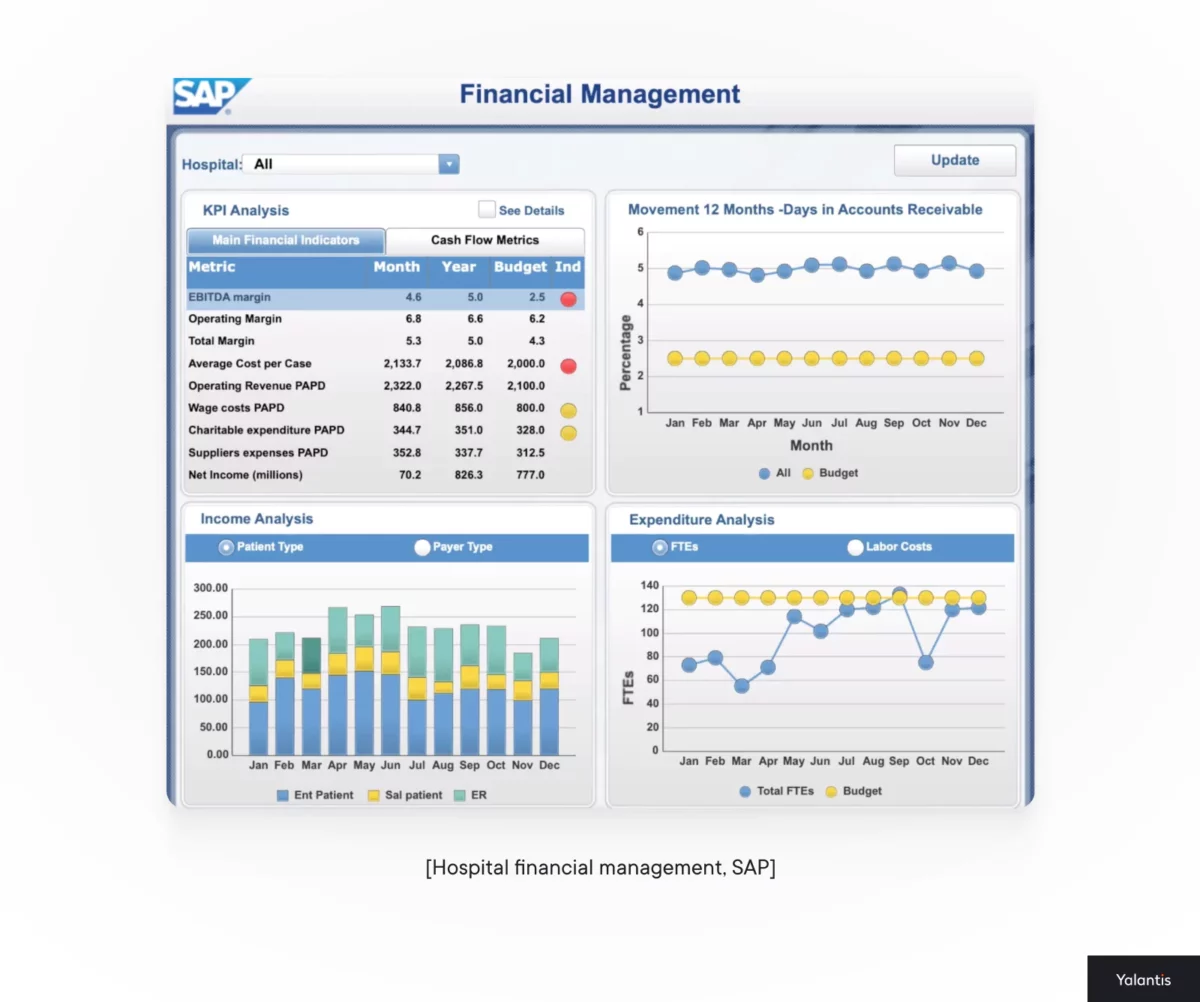
Amazon QuickSight
This cloud-based BI solution from Amazon has a pay-per-session pricing model, which allows clients to pay only when using the platform. Like the previously discussed BI options, Amazon QuickSight can be embedded into any existing product or system and can collect data from numerous file types (CSV, Excel) and databases (MySQL, PostgreSQL, Amazon S3, Amazon Redshift). Below are a few other distinctive features of Amazon QuickSight.
Key characteristics:
- ML-enabled engine. Amazon QuickSight is empowered with the SPICE in-memory calculation engine that ensures super-fast generation of analytics results.
- Natural language query tool. You can use the QuickSight Q tool and type any questions about your healthcare data in the search bar to quickly get visualized answers.
- High compatibility with AWS services. QuickSight seamlessly integrates with other AWS cloud services.
Built-in ML and AI solutions. Built-in machine learning and artificial intelligence algorithms allow for quick and effortless predictive analytics. - Template visuals and dashboards. Healthcare professionals can choose from a wide variety of ready-made dashboards to speed up data analytics.
- Community support. You can join the QuickSight community to share insights and discuss common business issues.
Prominent clients: Panasonic, Vyaire Medical, LucernaHealth, NFL
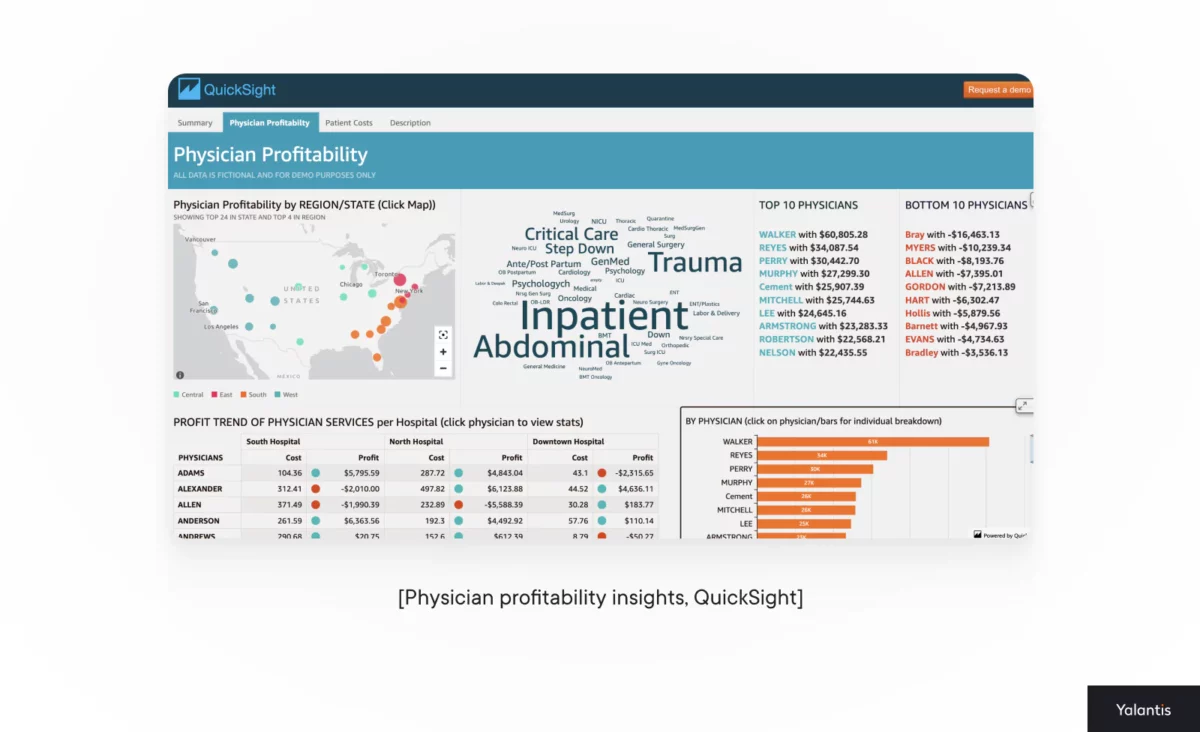
All of the business intelligence service providers we’ve mentioned have expertise in the healthcare industry. No matter which of these solutions you choose, it should be able to satisfy most of your healthcare data analysis needs. To enable tailored implementation and use of BI tools, our data engineering and ML consulting teams can help you find, integrate, test, and build a unified source of truth for your specific business and transform obtained data into customized actionable insights.
We can conduct thorough business intelligence and healthcare market research, compare pricing models, go through a few free trials with you, and eventually help you make the final decision that will bring the desired insights for your business to increase revenue, enhance patient care, and stay competitive in the market.
Process of implementing BI solutions in medical organizations
To ensure your BI software works as planned, you should prepare your data for effective analysis. Yalantis has developed a time-tested approach: a data readiness framework that can help you smoothly progress from the selection of suitable data sources to AI/ML-powered advanced analytics and ML solutions development. Here are 5 basic steps you should follow to seamlessly integrate BI into your healthcare workflow.
1. Prepare the data infrastructure. Map and connect all relevant internal and external data sources and set up a centralized data warehouse or data lake to gather structured and unstructured data. It’s also critical to implement ETL processes to transform data, clean inputs, and enrich data.
2. Establish data quality and governance practices. Before any analytics can generate value, the data must be accurate, consistent, and trusted. Poor data quality can lead to wrong conclusions and undermine user confidence in healthcare BI tools. Define data ownership and assign stewards for key datasets, and implement automated data validation rules to detect and correct errors. You should also develop a data governance framework that enforces consistency across departments.
3. Design custom dashboards. With high-quality data in place, it’s time to build dashboards that deliver relevant, role-based insights. Collaborate with end users to define what matters most and how they want to see it. For example, quality-of-care dashboards for clinical leaders or operational efficiency metrics for admin teams.
4. Set up role-based access and train users. To ensure successful adoption, make it easy for users to access and interpret the data they need, without compromising privacy or security.
5. Monitor performance. Post-launch, evaluate both system performance and business impact. Keep iterating to make sure your BI environment keeps up with changing organizational priorities.
Yalantis can become your guide at all stages of data preparation, collection, and analysis. Drawing on years of data engineering and analytics experience, we set up time- and cost-efficient data lifecycle management, and can help your organization improve the speed and accuracy of even the toughest healthcare decisions.
Turn raw clinical data into insights to increase the quality of care and competitiveness
Contact usWhy is business intelligence in healthcare becoming widespread?
The main reason for the increasing adoption of BI technology among healthcare providers is the need to make sense of increasing data volumes. The more digital solutions healthcare providers adopt, the more data is generated. And it’s getting harder to structure this data, aggregate it in a single storage location, and derive valuable insights from it. Also, hospital business intelligence solutions are popular among businesses that rapidly grow and expand their reach to new markets.
How can you assist with integrating BI in our healthcare practice?
To integrate the most suitable BI solution into your healthcare workflow and hospital systems, we determine your core business objectives and needs. We perform competitor and market analysis to define BI adoption rates in your specialization. Once we decide on the right solution and define which KPIs and metrics you need to track — and which outcomes you expect to achieve — our BI technology experts will set up an end-to-end data analytics process for your company to help you generate actionable insights and ensure data-driven decision-making.
How does the healthcare industry use business intelligence?
Healthcare business intelligence has a wide range of applications. For instance, healthcare practitioners can analyze data such as patients’ laboratory results, medication intake, and insurance claims to define treatment patterns, discover correlations, and make changes. With BI healthcare tools, you can also define how to optimize your daily workflow, reduce costs, ensure effective use of medical equipment, increase medical staff productivity, and improve patient outcomes. Advanced analytics, including predictive and prescriptive analytics, can help you identify trends and be better prepared for changes such as higher patient demand.
How many BI healthcare solutions have you integrated for your clients?
In 10 years of delivering healthcare software solutions, we’ve established a robust BI data analytics flow for more than 20 healthcare providers. We always select a unique integration approach to make sure the chosen BI solution satisfies a practice’s core needs.
Rate this article
4/5.0
based on 26 reviews






